What are Lizards?
Lizards are small reptiles with four legs and a long tail.
They crawl up to your walls and ceilings to find food. Lizards eat a variety of tiny insects such as flies, mosquitoes, and spiders.
Types of Lizards
There are over 6,000 species of lizards worldwide. Below are the ones most commonly found in homes.
Western Fence Lizard
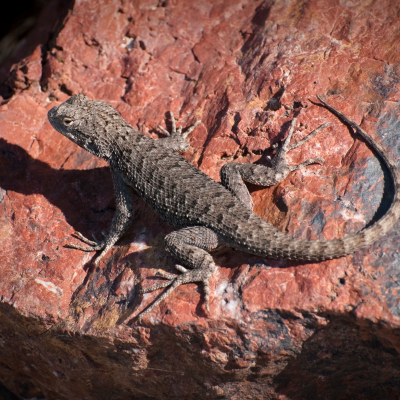
Western fence lizards are grey or tan lizards common in California, Nevada, Washington, Oregon, Idaho, and Utah.
They grow to be around eight inches long. Their legs are dotted with darker colors making them distinct from their bodies.
Their bellies range from white to yellowish. Male Western fence lizards may have bright blue patches on their stomach.
Western fence lizards eat small insects such as beetles, flies, ants, and spiders.
These lizards generally feed outdoors but may sometimes stumble inside your home.
You’ll generally see Western fence lizards in grasslands, farms, and forests.
Brown Anole
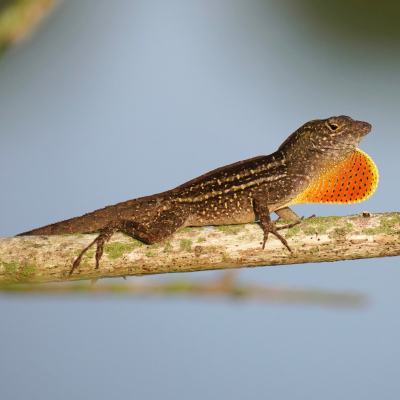
The Brown Anole is a small lizard with colors ranging from grey to brown. Female Brown Anoles are generally lighter in color than males.
The Brown Anole grows around five to nine inches.
They are distinct in that they have diamonds or lines running down their backs. Male Brown Anoles have a brightly colored throat fan, also known as dewlap.
The Brown Anole was first introduced to South Florida from the Caribbean. Today, you can find Brown Anoles in different states, including Louisiana, Coastal Georgia, and even Texas.
These lizards feed on small insects such as spiders, flies, crickets, beetles, mosquitoes, and ants.
Brown anoles expansion across the country has been linked to declining green anole populations.
Green Anole
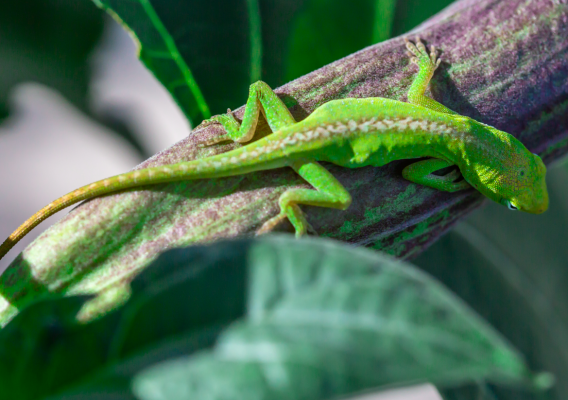
Green anoles are green in color. But, they can change from green to brown with the changes in temperature and humidity.
Like most lizards, Green anoles have long tails and slender bodies.
They have narrow heads and a bluish tint around their eyes.
Like Brown Anoles, Green Anole Males have a throat fan. Their thratfans have a bright pink or red color.
Male anoles use their throatfan, known as dewlap, for attracting mates as well as intimidating other males.
You can find Green anoles in many similar places as brown anoles, including Southern Virginia, Florida, Texas and Oklahoma.
Male anoles live outdoors. They like to stay in areas with high humidity and vegetation. You’ll often see them in swamps, forests, wooded beaches.
Green anoles feed on small insects such as spiders, flies, crickets, butterflies, moths, and ants.
Common House Geckos
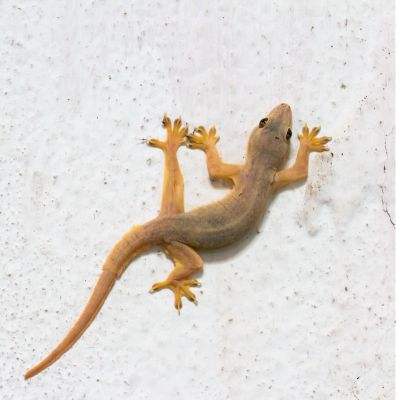
Common House Geckos are commonly found in Southeast Asia and the Pacific. You can also find them in Florida and Hawaii.
They eat tiny insects including mosquitoes, moths, and spiders. As such, you’ll typically see Common House Geckos where these insects usually are– on walls and ceilings.
They are grayish-white and grow to about five to six inches long. You’ll also notice tiny dark spots on their backs if you look closely.
Green Iguanas
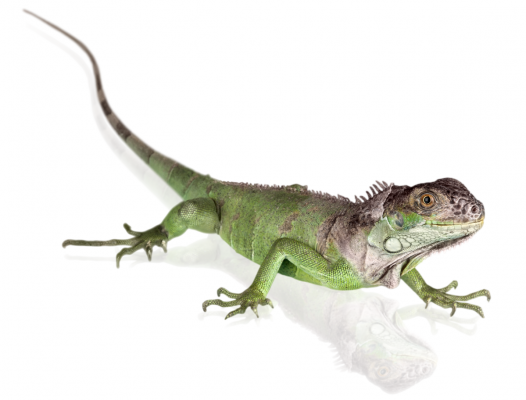
Green Iguanas are invasive lizards native to South and Central America and parts of the Caribbean.
They came into the U.S. via trade. You can find them in several states, including Florida, Hawaii, and Texas.
Green iguanas’ body and tail combined can grow up to 6 1/2 feet long. These lizards also grow heavy at about 10 to 15 pounds.
Green iguanas are green. However, males change colors from green to orange to attract mates.
Green iguanas have distinctive dark bands on their body and tail.
They have a large dewlap or throat fan.
You’ll most likely see Green iguanas near water and vegetation.
These lizards feed on plants. So you may see them in your garden. Homeowners have reported these lizards destroying their garden flowers and vegetables.
Gila Monster
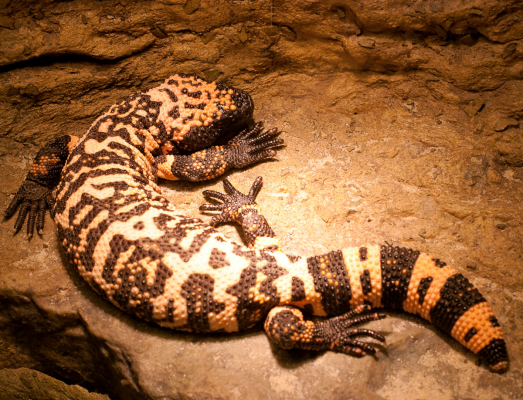
The Gila monsters are large lizards found across the US. You’ll encounter these lizards in Arizona, California, Utah, Nevada, and New Mexico.
These lizards have a large head and a short tail. Their skin is tan and black in color.
Signs of Having House Lizards
Are you wondering if you have a lizard or a blown-out lizard infestation in your home? Here are some signs that you’re right.
1. Seeing Lizards Around Your Home
Common house geckos love hanging out on walls and ceilings.
If you see a few of them hanging out in your ceiling consistently, then it’s likely you have lizards living in your home.
To be sure, check how they got into your house. It could be that they came in through open doors and windows. Or you may have a small crack on your wall where the lizards can come in.
2. Squeaking Noises
Lizards create distinct squeaking, hissing, or chirping noises.
You’ll hear chirping sounds at night if you have a common house gecko. That’s because Common house geckos are nocturnal.
Most lizards create a hissing or squeaking noise. If you hear this consistently in your home, then you may have an infestation.
3. Droppings
Lizard dropping size varies depending on the species. In general, small lizards produce droppings the size of a penny. More giant lizards have much bigger droppings.
That said, these reptiles’ dropping has something in common.
Lizard droppings are black and generally have a white tip. This color comes from crystallized uric acid that forms during digestion.
You’ll generally see lizard droppings grouped.
4. Tail Drag Marks
Look for tail drag marks in areas where there is dirt around your home. Lizards typically leave a thin straight line on dirt as they walk on it.
How To Get Rid of Lizards
1. Use Insecticides
Using insecticides is one of the easiest ways to remove lizards from your home.
For this, you can either use liquid or granules.
Liquid insecticide allows you to spray around your yard and other surfaces lizards frequent,
You can spray liquid insecticides on your walls, ceilings, and fences.
Granules are excellent for areas that are hard to reach.
You can place them on soil, bushes, or plants.
You can activate granule insecticide using water.
When using insecticide, look for one with residual effect.
Having a residual effect means that the insecticide will have a lasting impact on areas you’ve treated.
Any lizard that comes in contact with the treated area will be killed or repelled. Depending on the product, this residual effect can last for up to 3 and 6 months after the initial application.
The main disadvantage of using insecticides is that they’re generally not safe for children and pets. You’ll also want to keep them away from edible plants.
Also, insecticides can affect beneficial insects and animals that are currently living in your yard.
Animals commonly found in yards such as frogs and squirrels will be affected by the insecticide.
The best way to use this type of treatment is on high walls and ceilings. Applying it on hard to reach areas will limit the effect of the insecticide to only the lizards.
2. Kaffir Lime Essential Oil
Kaffir lime essential oil is an excellent natural alternative to insecticides. It is excellent at repelling lizards.
One study showed that at a 50% concentration, there was a 90% repellency.
The study also showed some residual effects. In particular, it demonstrated that there was significant repellency 6 hours or more after the initial application.
For this method, mix the essential oil in a spray bottle and apply it on surfaces where the lizards frequent.
3. Garlic
Garlic is another natural alternative to repelling lizards.
To use garlic as a lizard repellent, place individual cloves in places where lizards frequent.
Make sure to keep it away from your pets as it can be toxic to them.
You can also crush garlic and mix it with water to create a spray.
4. Cayenne Pepper
Cayenne pepper is another popular natural repellent spray against lizards. While harmless, the pepper is irritating to lizard skin, forcing them to avoid it.
For this, mix the pepper into the water and spray it in places where lizards frequent.
If you apply it outdoors, I recommend reapplication every couple of days as the elements can minimize its effectiveness.
5. Glue Traps
Glue traps are a great way to catch and get rid of lizards.
You can place these traps in any other areas where lizards frequent. They work as both indoors and outdoors traps.
To make it more effective, you can add food to the glue board.
One major disadvantage of this, however, is that the glue traps will likely kill lizards. This is because once the lizard is glued, you won’t be able to get them off.
6. Seal Your Home
Lizards generally live outdoors. To keep them outside your home, make sure to seal any voids, cracks, and crevices that are 1/4 inch or larger.
Check your walls, doors, windows, ventilation screens, water pipes, etc.
Replace or fix any broken screens in your home.
I also recommend that you install screens or covers to your basement and attic vents.
7. Keep Your Yard Well Maintained
One of the best ways to keep lizards away is to keep your yard and garden well maintained.
Lizards feed on tiny insects. Having an unkempt yard attracts other pests that are a perfect meal for lizards.
Doing so will not only keep lizards away but all sorts of other pests from infesting your home.
Insects love thick vegetation. It provides a safe place for them to live and reproduce. To keep pests away, make sure to trim, mow your lawn, and trim any excess vegetation.
Eliminate excess water sources. Moisture is key to many insects’ survival. So, the less you have around your home, the better.
Make sure to fix leaky faucets. Dump any standing water.
8. Eliminate Other Pests
Lizards feed on tiny insects. So, one of the best ways to keep them off your property is by getting rid of pests.
For this, I recommend a natural option such as Diatomaceous Earth (DE).
While using commercial pesticides can work, they will likely kill the lizards in the process.
DE is harmless to lizards, animals, and humans. But it will kill most pests and are easily available for purchase online or your local stores.
How to Prevent Lizards From Invading Your Property
Now that we saw how to get rid of lizards, it is time to learn a few methods to prevent them from trespassing.
1. Seal Any Entrance
To keep lizards outside your home, make sure to seal any voids, cracks, and crevices that are 1/4 inch or larger.
Check your walls, doors, windows, ventilation screens, water pipes, etc.
Caulk is cracked and holes in the walls, floors, and doors.
Replace or fix any broken screens in your home. Screens also help keep insects out of your home, giving lizards less reason to be inside.
I also recommend that you install screens or covers to your basement and attic vents.
2. Remove excess moisture
Lizards need food and water to survive. To keep them away, make sure to remove any excess moisture.
Doing so will not only prevent lizards from seeking water on your property, but will also keep other insects away. Since lizards feed on insects, removing moisture from your home means there will be no food for the lizards.
Eliminate excess water sources. Make sure to fix leaky faucets. Dump any standing water. The less you have around your home, the better.
3. Trim Vegetation
Lizards feed on insects. So, if you have plenty of insects in your home, you’re likely to attract lizards.
One of the easiest ways to keep insects away is by keeping your yard and garden well maintained.
Doing so will keep insects away and in effect keep lizards away.
Thick vegetation provides insects shelter and a place to reproduce. To keep pests away, make sure to trim mow your lawn, and trim any excess vegetation.
4. Get Rid of the Clutter
The less stuff you have in your home, the less places lizards have to hide. This goes for pests too.
So, the more organized your place is, the less ideal it is to be a breeding ground for lizards and other pests.
Are Lizards Dangerous?
Lizards are generally harmless to humans and pets.
Out of the thousands of lizard species, the only venomous lizard in the U.S. is the Gila monster.
That said, house geckos can bite when cornered and threatened. Their bites can be painful as they have teeth capable of tearing your skin. Iguanas have less painful bites. But, their bites can still break your skin.
The biggest danger posed by lizards is their ability to spread Salmonella. Lizards can carry Salmonella on their mouths and feces. So you can get Salmonella from lizards with both direct and indirect contact.
While Salmonella is harmless to lizards, it can make humans very sick. It can cause flu-like symptoms and sometimes even be life-threatening.
Do Lizards attack humans?
Lizards will generally not attack you. But they can when they are threatened.
House gecko bites can be painful as they have teeth capable of tearing your skin. Iguanas have less painful bites. But, their bites can still break your skin.
Most lizard bites are not venomous or poisonous.
Out of the thousands of lizard species, the only venomous lizard in the U.S. is the Gila monster.

The article did not address how to discourage or eliminate green iguanas. I live in Florida on a canal. I had 20 of them in my yard today. Various sizes. They deficate on the seawall and eat plants in the garden.